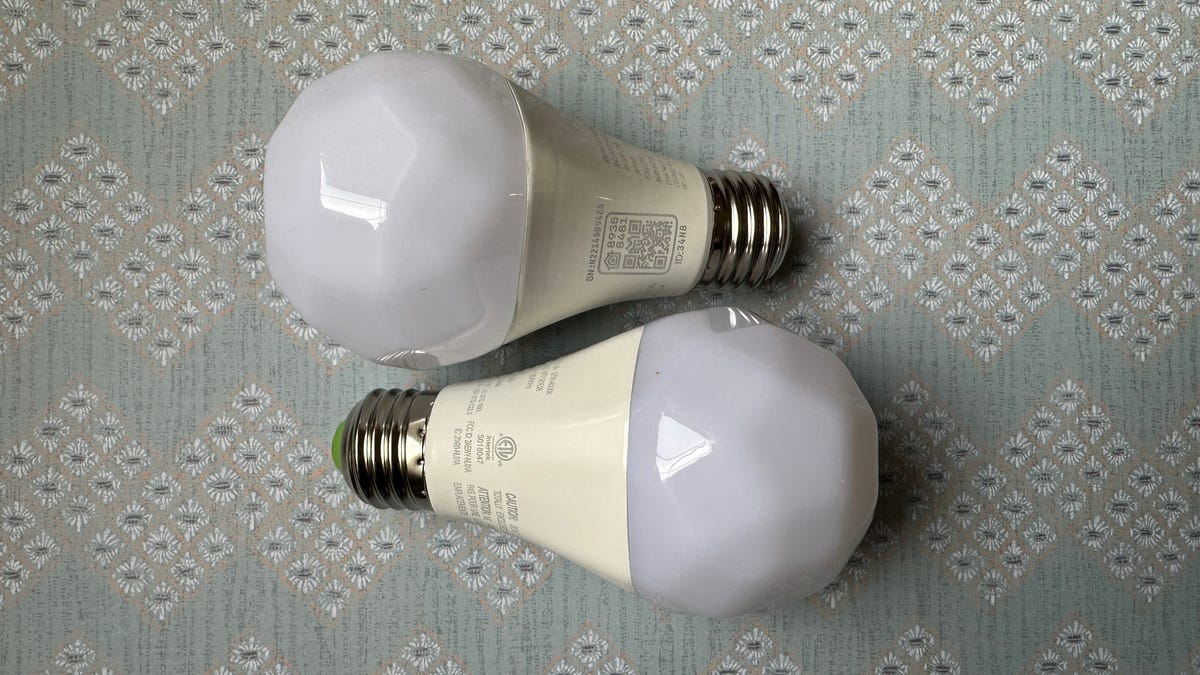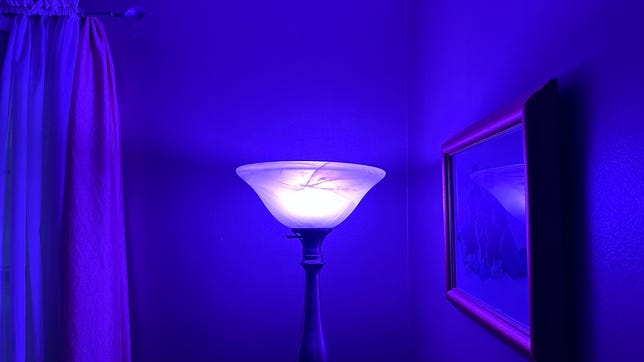 Why You Can Trust CNET
Why You Can Trust CNET Nanoleaf Essentials Bulbs Review: Light Up Your Smart Home
Nanoleaf's colorful smart bulbs are gorgeous, but controlling them isn't as intuitive as you'd hope.

The Nanoleaf Essentials Bulbs are fully customizable LED smart lights. You can set them up and control them with the Nanoleaf app, Apple HomeKit and Siri, Alexa, or Google Assistant. The color range extends to over 16 million colors, including any shade of white you can imagine. The bulbs themselves have a distinctive geometric shape rather than a typical round or oblong shape. They also connect to Thread, which is purported to be a faster, more stable network technology to enhance the smart home experience.

Nanoleaf Essentials Bulbs
Like
- Over 16 million colors
- Attractive bulbs
- Can set up scenes
- Thread-enabled
- Can be grouped with multiple bulbs
Don't like
- Nanoleaf App isn't intuitive
- Difficult to access all of the features
You don't need a special lamp for the Nanoleaf Essentials Bulb, as they'll work with any standard wattage-appropriate lamp. I tested them out in a floor lamp and two table lamps that predate the smart lighting era and they worked just fine. You can purchase just one Nanoleaf Essentials Bulb or you can buy several and synchronize them in the app, which is what I did.
These bulbs will fit nicely into any smart home, but they weren't as easy for me to set up as I'd hoped. If you don't mind taking some time to sort through the settings, or if you've already set up a smart home and are just looking to add in a couple of additional lights, then you'll enjoy the Nanoleaf Essentials Bulbs. Retailing at $20 for one or $50 for three bulbs (cheaper if you can catch them on sale), they are a quite bit cheaper than other HomeKit-enabled color-changing bulbs like Philips Hue, especially considering the fact that they connect over Wi-Fi and thus don't require any additional hub hardware.
Nanoleaf Essentials Bulb
Nanoleaf smart home compatibility and design
The Nanoleaf Essentials Bulbs look like typical lightbulbs except for the unique geometric design. If you use an opaque or translucent lampshade, you won't even see that, but it's a fun touch regardless. At their white light settings, each bulb will put out the same amount of brightness as a typical 75W bulb from an actual power draw of just 9W. It maxes out at 1,100 lumens, which means that it's putting out an impressive and efficient 122.2 lumens per watt.
The Nanoleaf Essentials bulb has a cool geometric design
These bulbs are Thread-enabled, but what exactly does that mean? Thread-enabled devices communicate with one another and connect to form a reliable, self-reinforcing mesh network over your existing Wi-Fi network. I didn't perform a before-and-after test, but I did find the bulbs' connection to be quite fast and stable, with no dropped connections and no noticeable lag time in the controls. Note that if you have a compatible Thread border router such as an Apple HomePod Mini set up in your home already as I do, the Nanoleaf Essentials Bulb will automatically begin using Thread. No additional steps are required. I checked my settings in the Nanoleaf app, and my Nanoleaf bulbs are indeed connected to the Thread Network.
Nanoleaf will also be supporting Matter, a new, universal language that all of your favorite platforms will "speak" in order to enable smoother cross-platform smart home connections. The standard is still in the midst of its launch -- some Matter-enabled features are live on Android, with iOS and Thread support coming in early 2023. Nanoleaf promises to be at the forefront of this technology as it rolls out, so it's a safe bet that these bulbs should be ready to take full advantage of Matter in the coming year. Even absent Matter, these bulbs already work with all of the major players -- Apple, Amazon, Google, etc. -- so they'll be able to fit right in with just about any smart home setup.
The Nanoleaf Essentials Bulbs' default white mode looks no different than the light from regular bulbs
Nanoleaf performance and features
I had mixed results in my testing on the performance front. Don't get me wrong: The bulbs themselves performed beautifully. The light they shed is lovely, and I enjoyed trying out different colors and brightness settings. However, I found the Nanoleaf app's user interface to be pretty frustrating, with no easy way to access and control all of the bulbs' great features, like colorful scene setups. I used the Apple Home app as well, which is a bit more user-friendly for basics like grouping lights and turning them on and off, but more limited and lacking in advanced, product-specific features.
Setting up the bulbs in the app is pretty easy: It's a matter of scanning the code on the side of the bulb (or on the packaging) and following the prompts on screen. You can do this either in the Nanoleaf app, Alexa app, Google Home app or Apple Home app. I set up one of the bulbs initially in the Apple Home app and the other two in the Nanoleaf app, and it worked fine both ways. From there I was able to group the bulbs together in the Nanoleaf app, which wasn't intuitive at all, but I figured it out. At least the group I'd formed in the Nanoleaf app showed up automatically in the Apple Home app as well.
Nanoleaf app screenshots
I started by testing the group controls in the Nanoleaf app. Turning the bulbs on and off as a group was easy and intuitive, but sometimes I had to tap the off/off button twice for it to take. I performed the same test in the Apple Home app, and it worked better: I never had to tap it twice.
I tried out voice control, in my case "Hey Siri." Siri voice commands worked fine for turning on the grouped bulbs. But when I tried to turn them off via Siri, I got an error message stating, "That's not supported." When I tried to control one of the bulbs via Siri voice command, it turned off a different one. I realized that was due to operator error, though: I had named one of the bulbs "Nanoleaf" and the others "Nanoleaf K" and "Nanoleaf B." When I tried to control Nanoleaf K and Nanoleaf B via Siri, it only heard "Nanoleaf" and acted accordingly. So, I changed the name of the bulb "Nanoleaf" to "Nanoleaf L" and now Siri works fine. So, word to the wise: Make sure that every bulb has a unique name, and that one isn't just a shorter version of another.
Next, I tested the Nanoleaf Essentials Bulbs' whites. There's a huge range of whites from nearly blue to pretty yellowish. The default white is just about as white and bright as the standard bulbs I'd been using. The dimmest setting is about as dim as you could expect.
Then I used the Nanoleaf app to set the bulbs to the following colors: red, blue, yellow, green, orange, purple, pink, cyan. Most of the colors are not the straight primary or secondary colors you might expect, though I aimed for smack in the middle of the range in the color picker. Red is more pink than red. Blue is kind of a purply blue. Yellow is lemon yellow, softer than primary. Green is pretty lime. Orange has a reddish/pink cast. Purple is on the lavender side. Pink is more of a fuchsia. Cyan is just cyan. All colors are definitely dimmer than white, even on the brightest setting, which is what you'd expect. You can save up to seven favorite colors in the Nanoleaf app or up to five in Apple's Home app.
The Nanoleaf app is limited and not very intuitive
Nanoleaf's app gets in the way
I tried to use the Nanoleaf app to create a mixed color scene. But it was not at all intuitive. I couldn't actually figure out how to create a mixed color scene or any scene at all. There are a ton of very cool preset scenes in the Nanoleaf app, which I could download and play with a tap. Many of them are created by the Nanoleaf community and intended for the company's multicolor light panels. However, I could not figure out how to apply their colors to my bulbs, or create scenes of my own. I wasn't even able to make the scenes stop easily, I had to tap and hold on each bulb within the Nanoleaf app to adjust it back to white.
The Nanoleaf Essentials Bulbs offer Circadian Lighting, which automatically adjusts color temperatures to complement your body clock. In other words, the lights will be warmer in the evening as you prepare for sleep and cooler in the morning as you're waking up. I set this up in the Nanoleaf app (or at least I thought I did; it appears to be configured correctly in the app) but cannot visually detect a difference in the color temperature myself.
Final thoughts
Whether you've already got a smart home setup or you're looking to dip your toe into smart home waters, Nanoleaf Essentials Bulbs are a worthwhile addition to your home. If your needs are pretty simple, you'll have them set up and working in no time, regardless of which platform you're using to anchor your connected living space. Since the bulbs are Thread-enabled, you can expect a fast and stable connection, even better than Wi-Fi or Bluetooth, and thanks to Matter, you can expect that connections with smart home devices from other brands to be even more streamlined in the coming year. Just be prepared to spend some time exploring and experimenting with the app to figure out how best to put these bulbs to work.
It's worth noting that while there are tons of app-enabled color-changing bulbs on the market, and not many of them are Apple HomeKit-enabled. There are few notable brands like Philips and Lifx that make colorful HomeKit-enabled smart bulbs, but the Nanoleaf Essentials Bulbs are substantially less expensive. That makes these smart lights an intriguing value for anyone, and a particularly great value for Apple HomeKit users.

